Private Cellular has been around for quite a few years. It's always been a technology that I thought had some great applications, but the complexity and applicability made it a challenge to talk with my clients about. While various solutions have popped up to make it easier, they still require a good amount of overhead. I also have to admit that I'm not *super* familiar these days, as it hasn't really made the move into the market segment that most of my clients sit in. So I was excited to hear from Celona about how they're making private cellular more accessible to the mid-market segment. And WOW did they deliver. They had a very straightforward 5-part agenda, and 2 of those sections of it blew me away.
Whats new
 We started with a general update and "what's new." This section had Mehmet Yavuz, Celona's co-founder and CTO, walking us through their history at Mobility Field Day events and providing an overview of how what they were covering today fulfilled what they said they would do last year when they presented. I really appreciated the continuity that this section provides. One of the things we often see in tech is announcements being made that aren't followed through on. Sometimes these can be small features that never materialize, changes in a product's direction, or occasionally, entire companies going missing after being acquired. So having this section of "here's what we said we would do then, and here's how we delivered it" is REALLY helpful, especially for folks who may not be as familiar with your products. So kudos to the Celona team for this one! It also gave us a small foreshadowing of the features they would discuss during the presentation. They also talked about their newly launched "Frequency" community. The members (who they lovingly called "freqs" (pronounced freaks) meet up to discuss real-world challenges with private cellular and talk through use cases, especially newly emerging ones.
We started with a general update and "what's new." This section had Mehmet Yavuz, Celona's co-founder and CTO, walking us through their history at Mobility Field Day events and providing an overview of how what they were covering today fulfilled what they said they would do last year when they presented. I really appreciated the continuity that this section provides. One of the things we often see in tech is announcements being made that aren't followed through on. Sometimes these can be small features that never materialize, changes in a product's direction, or occasionally, entire companies going missing after being acquired. So having this section of "here's what we said we would do then, and here's how we delivered it" is REALLY helpful, especially for folks who may not be as familiar with your products. So kudos to the Celona team for this one! It also gave us a small foreshadowing of the features they would discuss during the presentation. They also talked about their newly launched "Frequency" community. The members (who they lovingly called "freqs" (pronounced freaks) meet up to discuss real-world challenges with private cellular and talk through use cases, especially newly emerging ones.
Neutral Host
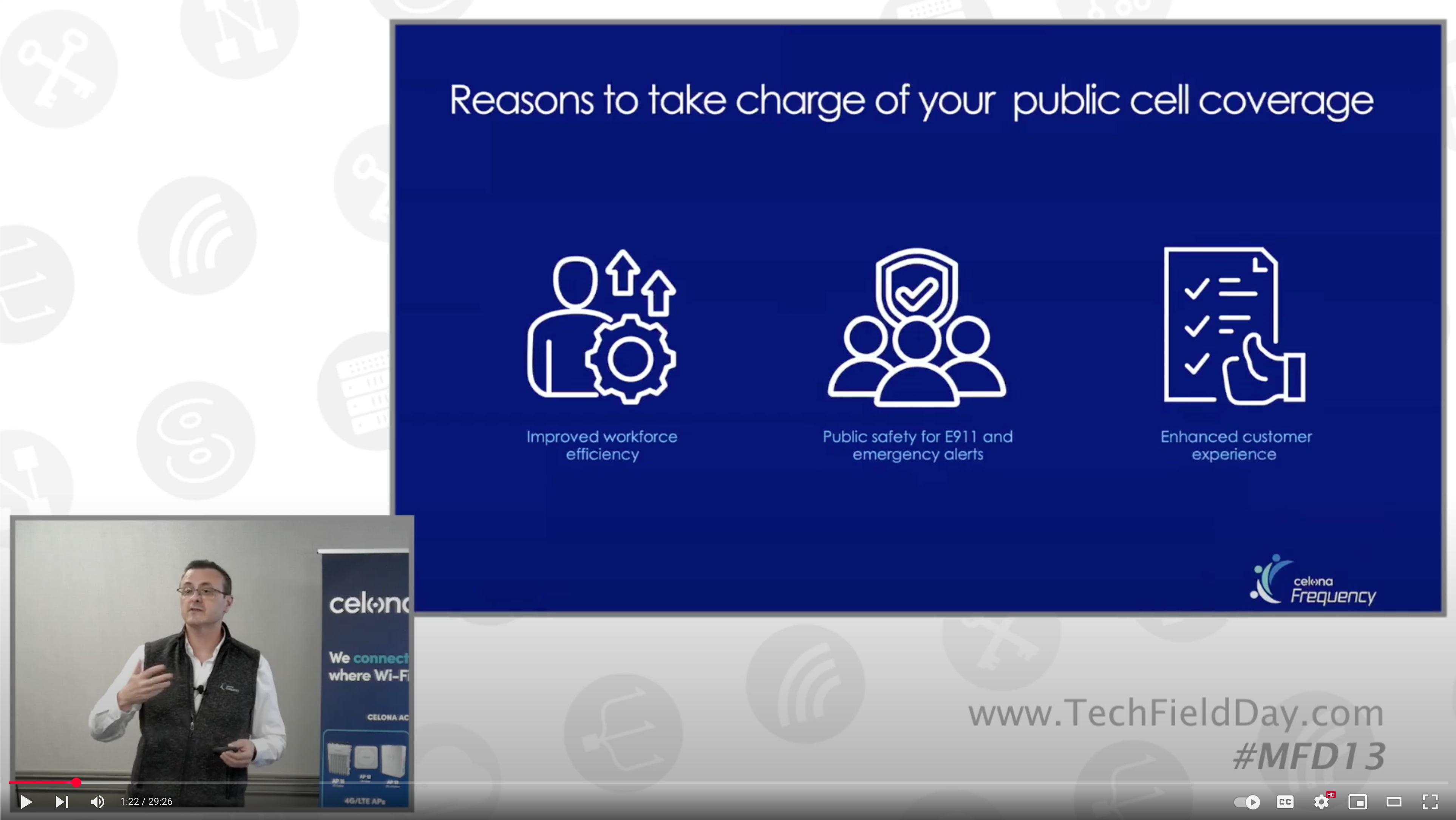 Now, being someone not as tapped into the private cellular world as others, this section was REALLY interesting. In the past, I've worked with things like Private Access Point Names (APN) on cellular connections, Digital Antenna Systems (DAS), and picocells. But these were all used to enhance the use of a cellular provider's network. When I've looked into the "current" wave of private cellular, it's always been focused on using private infrastructure to span larger distances (large oil fields, municipalities, etc) for private networking. But that would mean it's private infrastructure just for the people deploying it. I've been to several presentations at various events talking about this, but there was always a LOT of complexity. The diagrams were always filled with more random letter and number acronyms than you could shake a stick at. Things like RAN, UPF, UDM, SMF, 3GPP, S1-U, and NSAAUF had me throwing my hands up with a WTF?
Now, being someone not as tapped into the private cellular world as others, this section was REALLY interesting. In the past, I've worked with things like Private Access Point Names (APN) on cellular connections, Digital Antenna Systems (DAS), and picocells. But these were all used to enhance the use of a cellular provider's network. When I've looked into the "current" wave of private cellular, it's always been focused on using private infrastructure to span larger distances (large oil fields, municipalities, etc) for private networking. But that would mean it's private infrastructure just for the people deploying it. I've been to several presentations at various events talking about this, but there was always a LOT of complexity. The diagrams were always filled with more random letter and number acronyms than you could shake a stick at. Things like RAN, UPF, UDM, SMF, 3GPP, S1-U, and NSAAUF had me throwing my hands up with a WTF?
One of the things I have wondered about with the "new" private cellular offerings is their ability to offer a "public access network" that blends the 2. Like Wi-Fi (especially the new Passpoint, Open Roaming, Eduroam, etc, type federated authentication networks), you can let people join your network with minimal effort and gain access to the internet, but not your local network. Enter the world of "Neutral Host". The short version of this (in my words at least) is that a Neutral Host network allows a private entity to build a private cellular-based network that they can then connect to a cellular service provider who allows them to rebroadcast the public provider's network for use by guests. That sounds exactly like what I was hoping for! But don't just listen to my word on it; this blog article by Celona goes into much better detail about what they're talking about!
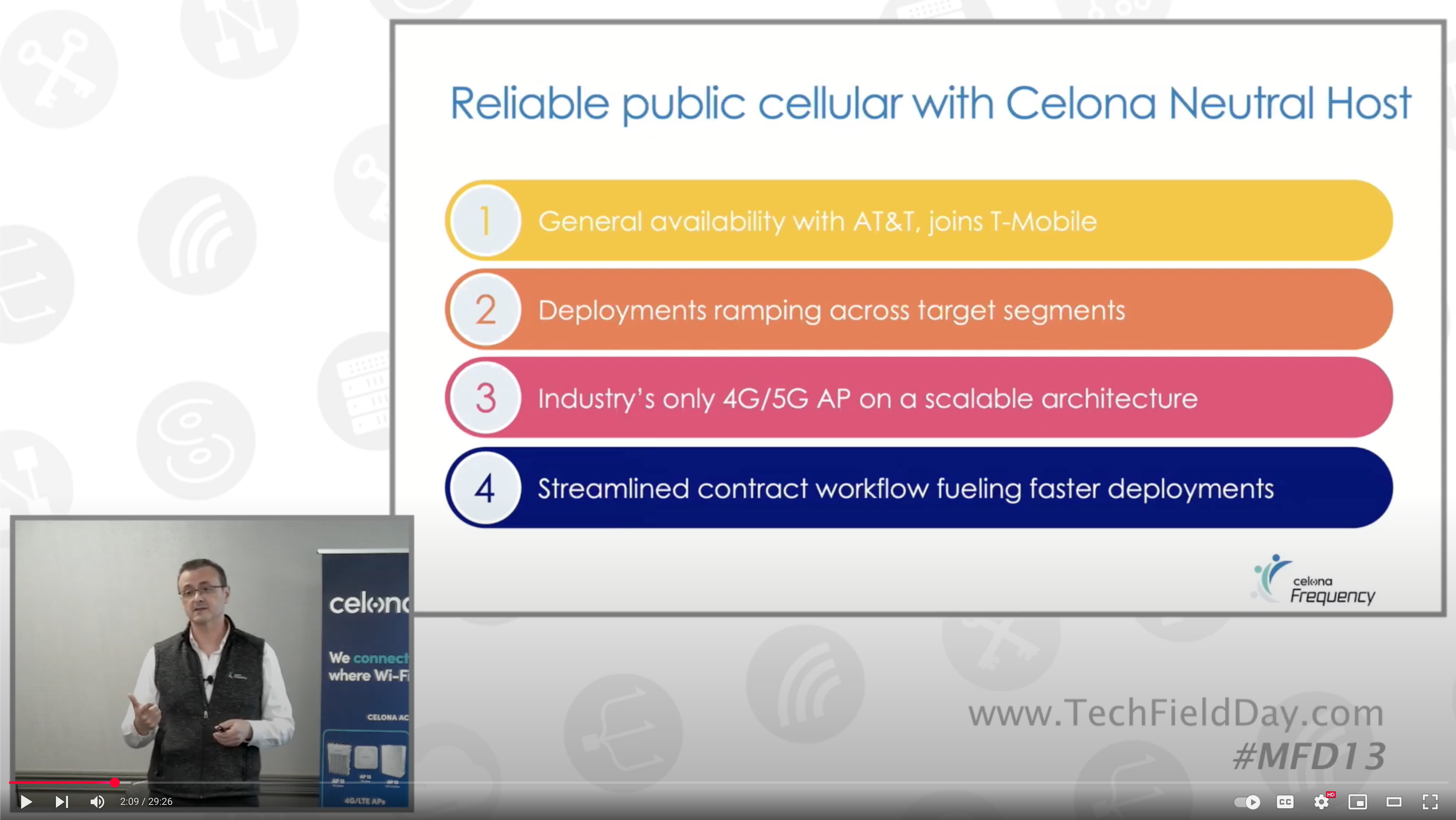 In this segment of their talk, Mehmet walked us through how they began offering this service last fall with T-Mobile and how they recently expanded to add AT&T. When asked about Verizon, we were told Verizon has waffled a little over the last few years on it, but currently doesn't support this use case. While not surprising, it is annoying. While Verizon has supported other systems (DAS, etc) it would be nice if they would get on board with this solution too. That could help accelerate private parties' ability to provide better services to their users, which would likely only help with satisfaction with Verizon's services.
In this segment of their talk, Mehmet walked us through how they began offering this service last fall with T-Mobile and how they recently expanded to add AT&T. When asked about Verizon, we were told Verizon has waffled a little over the last few years on it, but currently doesn't support this use case. While not surprising, it is annoying. While Verizon has supported other systems (DAS, etc) it would be nice if they would get on board with this solution too. That could help accelerate private parties' ability to provide better services to their users, which would likely only help with satisfaction with Verizon's services.
But, as we return to the presentation, the important thing is that this offering allows the private entities who deploy this technology the ability to enhance the public provider's network within their space. And it's seamless to the end user. You could walk into a facility where you used to not get any signal, and you notice that not only do you have a good signal (5 bars!!), but your phone still says ATT or T-Mobile. In the background, all kinds of fun have happened, though. Your traffic has jumped to a private cellular access point, negotiated your phone's connection with your provider, and is tunneling that traffic securely from the location you're in all the way out to the provider's network. So while you're using private infrastructure to get your signal, it looks just like if you were on the provider's direct network., And has the same level of security! This is a fantastic use case for places that may not be easy to deploy Wi-Fi or for cases where you don't want to force users to get on Wi-Fi. Think of a hospital (ok, this is because that was the use case they presented to us) where the building is full of concrete, conduits, lots of rooms, etc, all kinds of things that really break Wi-Fi signal propagation. You also have a lot of external users that you want to help support in having internet access to perform various activities, but helping someone get their phone on Wi-Fi continues to be a challenge (yes, even in the year 2025). But in this use case, they showed how, by deploying a Neutral Host solution, they could rebroadcast the AT&T and T-Mobile networks within the building. So a guest could walk into the hospital and get a good cellular signal without doing anything. They didn't even know they were on this private network. And that public network didn't impact the hospital's private devices and applications because it was fully segmented. They also took time to give us video demos of their testing where they could collect data proving how the solution really did do what it said it could. This was really cool to see how "easy" they made it all seem with really impactful results.
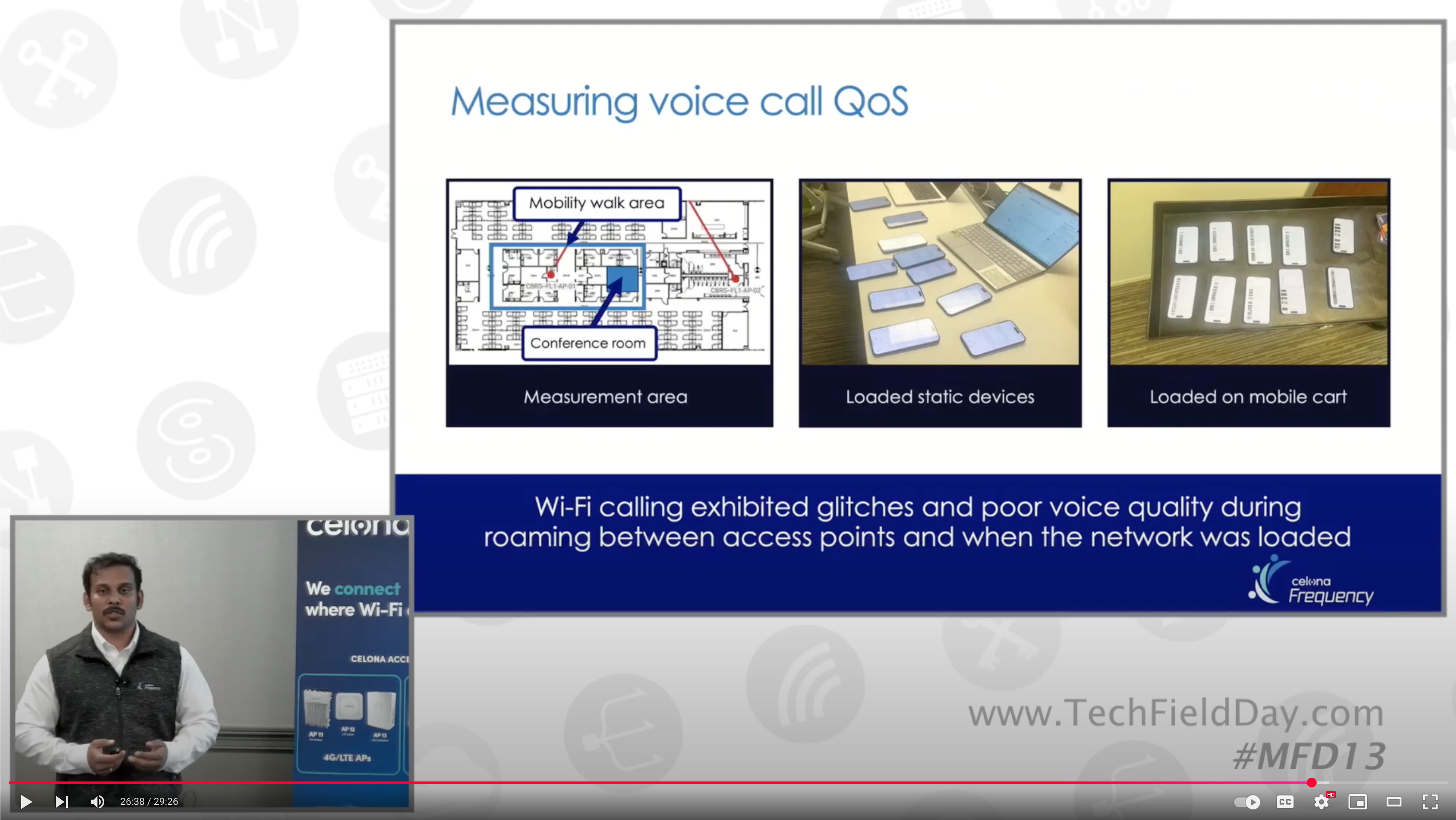 Sounds fantastic, right? But how much hardware does this take? I mean, in Wi-Fi, we deploy hundreds of APs to achieve full coverage in these kinds of large buildings. Celona said they usually see about a 5:1 ratio of Wi-Fi to Cellular APs. Since cellular uses different frequencies, the APs can cover more space. So in this use case, they deployed about 60 cellular APs to cover all of the buildings. That's not too bad! But what about everything else that's needed? If you look at those "5G" architectures, we have to account for all of the random acronyms splattered across the page. And that's where the following announcement really impressed me.
Sounds fantastic, right? But how much hardware does this take? I mean, in Wi-Fi, we deploy hundreds of APs to achieve full coverage in these kinds of large buildings. Celona said they usually see about a 5:1 ratio of Wi-Fi to Cellular APs. Since cellular uses different frequencies, the APs can cover more space. So in this use case, they deployed about 60 cellular APs to cover all of the buildings. That's not too bad! But what about everything else that's needed? If you look at those "5G" architectures, we have to account for all of the random acronyms splattered across the page. And that's where the following announcement really impressed me.
Celona Edgeless Architecture
 So we have a way to make the private cellular network more useful and to really drive some end-user satisfaction. But how easy is it to deploy? Are we talking about rolling in a semi-truck of equipment to get this working? We have definitely seen the change in i-Fi architectures over the years, so how does Private Cellular compare to that? The answer is (of course) it depends. While some private cellular providers have a half rack (or more) of equipment that has to be deployed, Celona had already made this easier by having a single "Edge" appliance. This physical or virtual appliance hosted all of the services necessary for the Celona on-premises solution (aside from the Cellular APs). But in this part of the presentation, Puneet Shetty, VP Product & Field Engineering, announced Celona's new "edgless" architecture. With this new architecture, the APs connect directly out to Celona's cloud for management and host all of the necessary dataplane services directly on the APs via microservices. This jump forward in private cellular mimics what we've seen happening in the Enterprise Wi-Fi space. And it really simplifies the private cellular solution.
So we have a way to make the private cellular network more useful and to really drive some end-user satisfaction. But how easy is it to deploy? Are we talking about rolling in a semi-truck of equipment to get this working? We have definitely seen the change in i-Fi architectures over the years, so how does Private Cellular compare to that? The answer is (of course) it depends. While some private cellular providers have a half rack (or more) of equipment that has to be deployed, Celona had already made this easier by having a single "Edge" appliance. This physical or virtual appliance hosted all of the services necessary for the Celona on-premises solution (aside from the Cellular APs). But in this part of the presentation, Puneet Shetty, VP Product & Field Engineering, announced Celona's new "edgless" architecture. With this new architecture, the APs connect directly out to Celona's cloud for management and host all of the necessary dataplane services directly on the APs via microservices. This jump forward in private cellular mimics what we've seen happening in the Enterprise Wi-Fi space. And it really simplifies the private cellular solution. 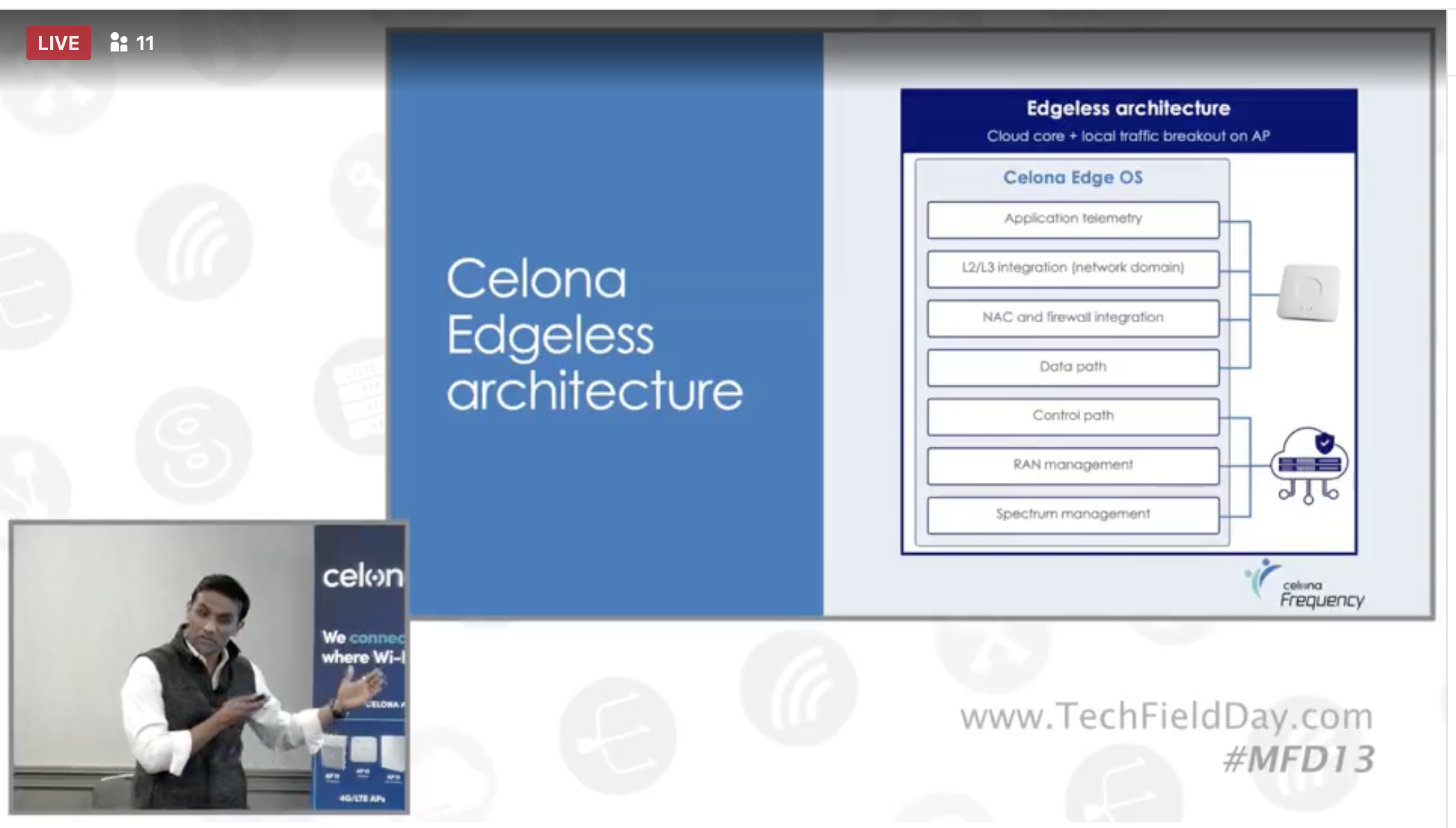
This gives Celona a very flexible, scalable, and simple solution that can adapt to the deployment environment as needed. And while many of the Wi-Fi geeks reading this are like "well yea that's why we've been going there," I don't think it can be overstated how much of a leap forward this is in the private cellular world. While other providers are trying to figure out how to roll the rack of gear onto the site, Celona's out here just plugging in an AP and are up and running (this is a somewhat simplified model, but not by much). MJ treated us to an awesome demo of this right there in the room. Celona had plugged one of their APs into the network and had a private cellular network up and running with some test devices. He did the classic "I'm going to unplug this and hope for the best" test. When the AP was unplugged, the devices lost their network access, and when he plugged it back in (to a PoE switch port), after just a couple of minutes of boot time, the devices were back up and on the network. It was pretty awesome when you realized just how much went on behind the scenes!
Celona Orchestrator and Orion (yes, it's AI)
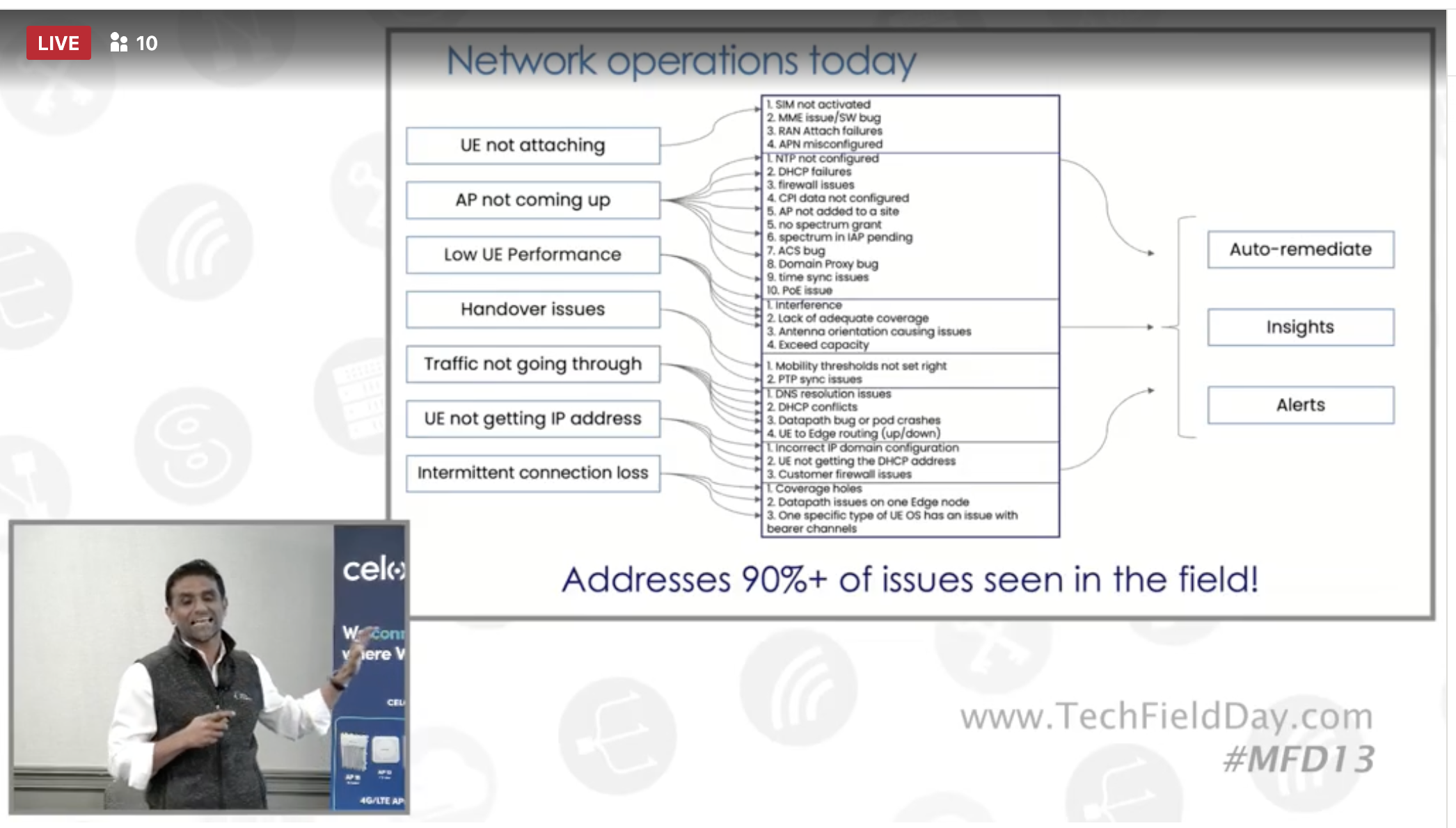 The next section of their presentation was the announcement of bundling an AI set of tools with their orchestrator platform. This orchestration platform makes managing cellular endpoints really simple. From provisioning to profile changes (think of them like access rules, etc.), you can dynamically manage your endpoints across the network regardless of their location. Combined with the edgeless architecture above, you can see how this makes the entire solution comparable to cloud-based Enterprise Wi-Fi systems. But since in cellular there is more provisioning and configuration done in the platform, this is kind of like the Wi-Fi management AND an MDM. They have bundled in AI models, tools, generative AI, etc., all to really bring the ability for the platform to perform to the level needed for more widespread adoption. So while I'm not spending a ton of time on this in the article, you should watch the whole video to see the demo. It was fantastic.
The next section of their presentation was the announcement of bundling an AI set of tools with their orchestrator platform. This orchestration platform makes managing cellular endpoints really simple. From provisioning to profile changes (think of them like access rules, etc.), you can dynamically manage your endpoints across the network regardless of their location. Combined with the edgeless architecture above, you can see how this makes the entire solution comparable to cloud-based Enterprise Wi-Fi systems. But since in cellular there is more provisioning and configuration done in the platform, this is kind of like the Wi-Fi management AND an MDM. They have bundled in AI models, tools, generative AI, etc., all to really bring the ability for the platform to perform to the level needed for more widespread adoption. So while I'm not spending a ton of time on this in the article, you should watch the whole video to see the demo. It was fantastic.
Conclusion
What Celona is doing with their solution set is really taking on the general adoptability of private cellular. While this type of "edgeless" architecture has become super familiar for those of us working on enterprise Wi-Fi, in the private cellular world, it is leaps and bounds ahead of where things are today for many of the providers. By offering this simplified and scalable architecture, especially when combined with the ability to provide Neutral Host services to enhance a general user's experience with zero configuration on their devices, Celona has something REALLY special in this offering. I'm already talking to my day job management at Nexum about considering this a solution that we discuss with our clients. Especially the ones where private cellular has been discussed before, but put away for being "too complicated."
Watch the Celona Mobility Field day 13 Presentation
P.S.
 One of the cool things about being a delegate for Tech Field Day events is that the presenters bring SWAG for you. And while I LOVE my SWAG, I thought what Celona did was REALLY cool. They made a donation on our behalf to Second Harvest of Silicon Valley to support their mission of feeding families in need. This showed that they, as a company, are really a class act, and it was a neat way to give back to the local community. Well done <hat tip>.
One of the cool things about being a delegate for Tech Field Day events is that the presenters bring SWAG for you. And while I LOVE my SWAG, I thought what Celona did was REALLY cool. They made a donation on our behalf to Second Harvest of Silicon Valley to support their mission of feeding families in need. This showed that they, as a company, are really a class act, and it was a neat way to give back to the local community. Well done <hat tip>.







